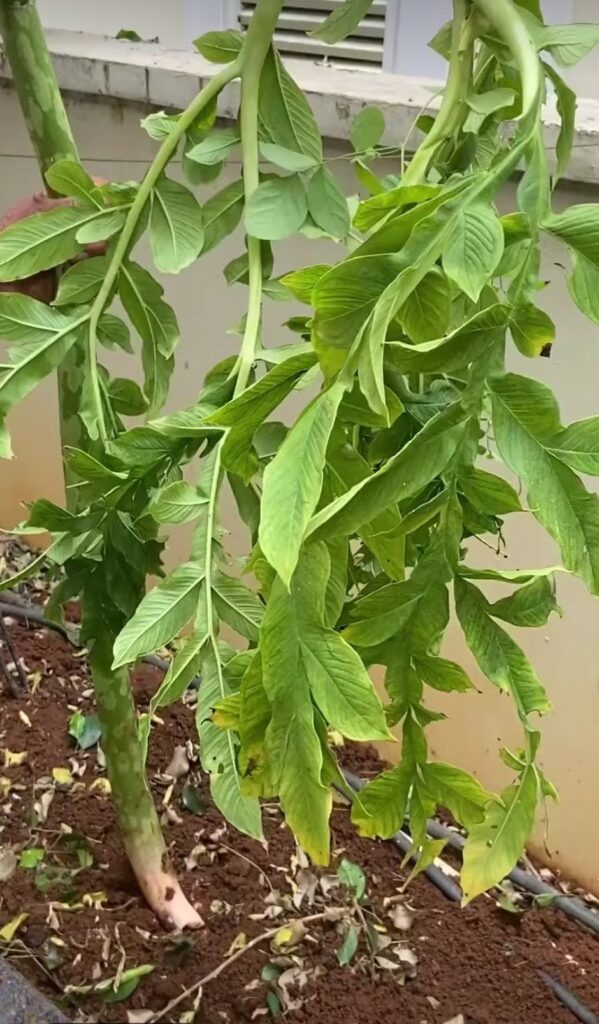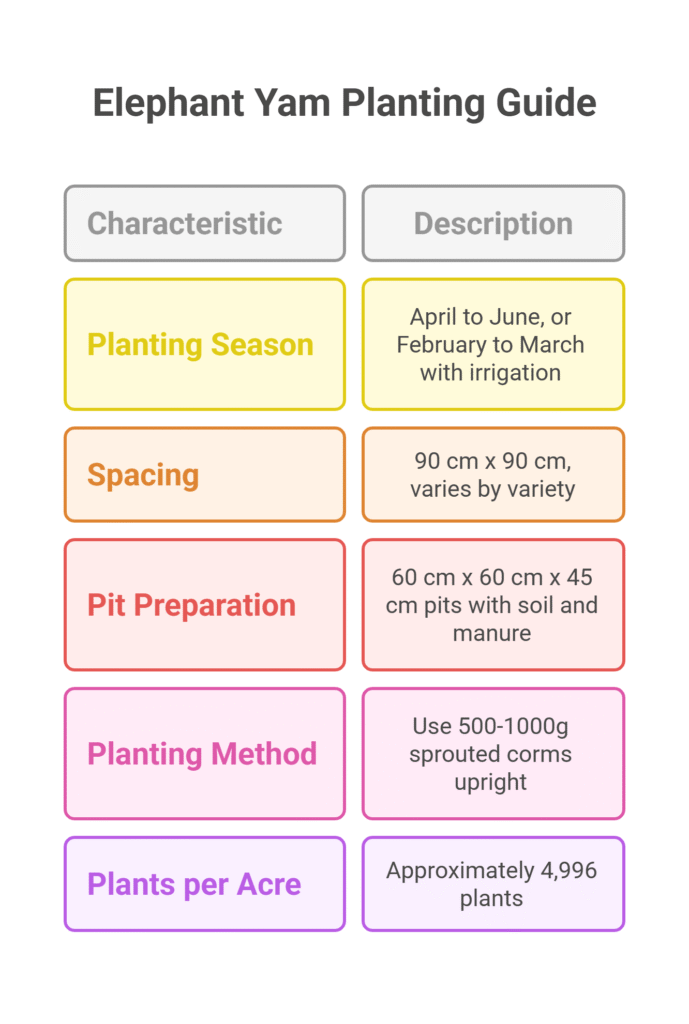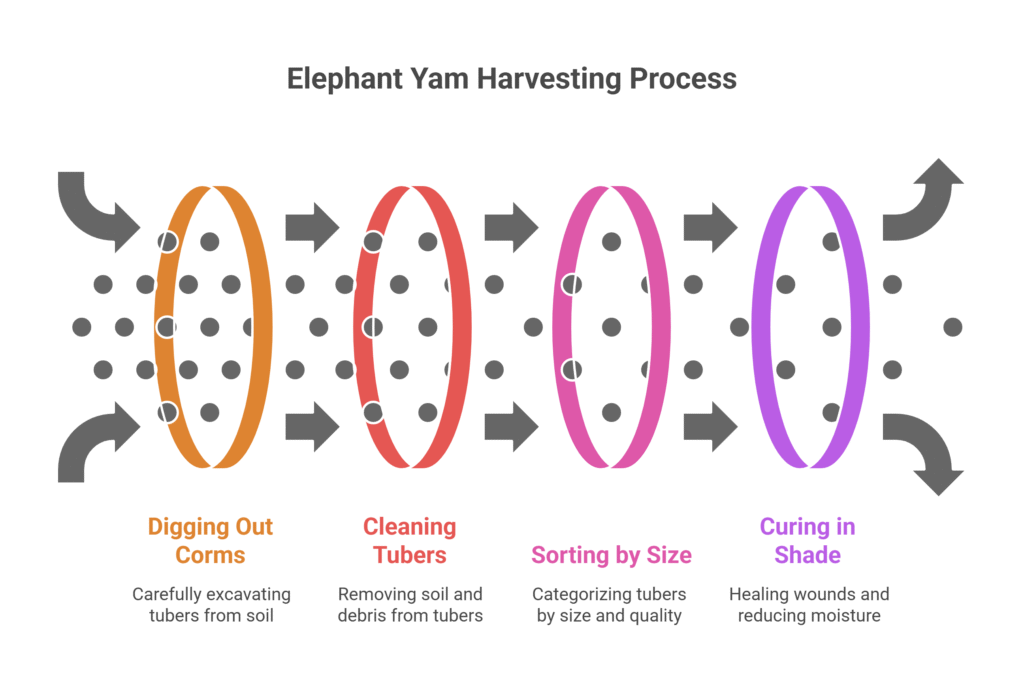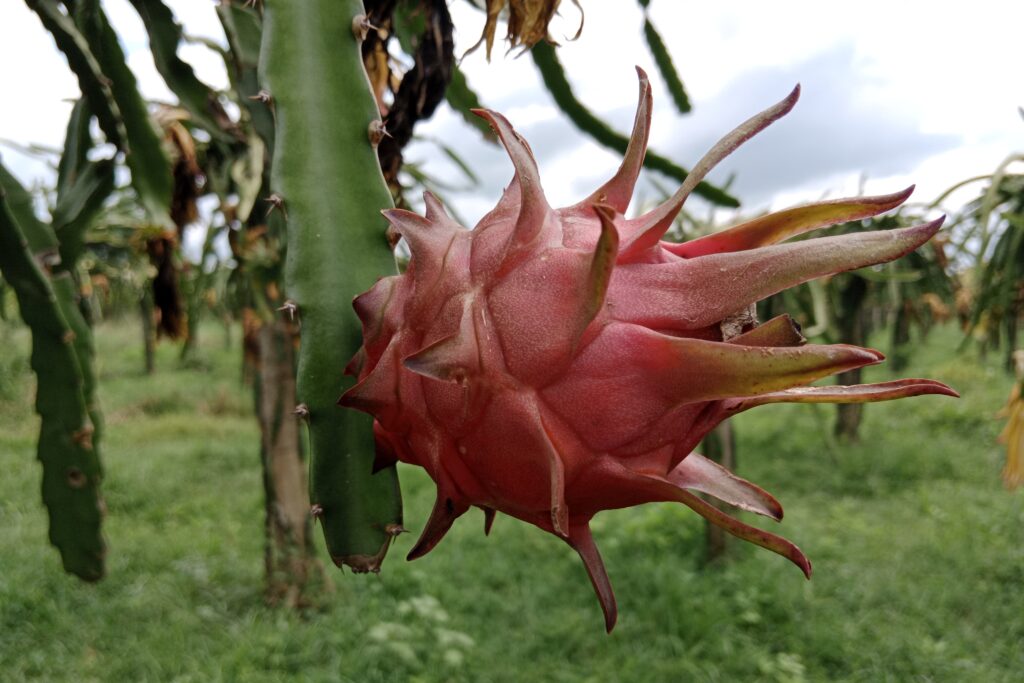Elephant Foot Yam Farming
Elephant foot yam farming has proven to be a highly profitable agricultural venture, particularly for farmers aiming to maximize returns with minimal input costs. An in-depth analysis of elephant foot yam farming profit per acre shows a substantial net profit of NRs 138,000, achieved by deducting the total investment of NRs 42,000 from the total income of NRs 180,000.

Additionally, the farming practice demonstrates strong economic viability, as reflected in the impressive Benefit-Cost Ratio (BCR) of 4.29, meaning that for every NRs 1 invested, the farmer earns NRs 4.29 in return. This level of profitability highlights elephant foot yam cultivation as an attractive option for both smallholder and commercial farmers.
Land Preparation
The field must be thoroughly ploughed two or three times to break up the soil and get rid of weeds. It must also be leveled and adequately drained to avoid water stagnation and tuber rot. In this phase, the soil should be fully mixed with 20 to 25 tons of organic manure per acre, such as compost or farmyard manure (FYM). Additionally, to enhance soil aeration and lower the incidence of disease, planting pits should be prepared around one month in advance.
Soil Type
Rich in organic matter, loose, friable, and deep to promote proper tuber development, kidney beans grow best in well-drained loamy or sandy loam soils. To minimize poor development and disease problems, thick clay or wet soils should be avoided. The optimal pH range for soil is between 5.5 and 7.0.
Climatic Requirements
Kidney beans, being a tropical crop, perform well in warm and humid environments with optimal temperatures ranging from 25°C to 35°C. They require a moderate to high amount of annual rainfall, typically between 1000 and 1500 mm, to support healthy vegetative growth. Although they benefit from rainfall during the early growth period, a dry phase is crucial during the maturity and harvest stages to ensure proper tuber development and minimize the risk of rot and post-harvest losses.
Major Cultivars
Elephant yam cultivar selection hinges on three key factors: market preference (dictating traits like tuber size, color, and consumer demand for better prices), disease resistance (crucial for minimizing losses from threats like leaf blight), and maturity duration (influencing harvest timing and potential for multiple cropping cycles). Farmers choose varieties offering the optimal combination for their specific needs. Improved varieties are listed below:
| Cultivar | Key Features |
| Gajendra | Popular, early maturing, high-yielding |
| Sree Padma | Tolerant to leaf blight |
| CO 1 | Suitable for commercial cultivation |
| Gajendra Local | Widely grown by farmers |
Planting
a). Planting Season
Planting is typically done at the beginning of summer or during the pre-monsoon season, from April to June, depending on the region and availability of irrigation. In areas with irrigation, planting can also be carried out earlier, during February or March.

b) Spacing
The standard spacing for planting is typically 90 cm x 90 cm, though this may vary based on the variety and soil fertility. Maintaining adequate spacing is essential for proper tuber development and effective disease control.
c) Pit Preparation
To guarantee healthy crop establishment, dig 60 cm x 60 cm x 45 cm pits and fill them with a mixture of topsoil, 2–3 kg of farmyard manure (FYM), 250 g of neem cake, and 50g of Trichoderma viridae before planting.
d) Planting Method
For successful elephant yam planting, use healthy, disease-free seed corms (mother corms or pieces) weighing 500–1000 g that have already sprouted, as this promotes better establishment. Carefully place the selected corm upright in the center of the prepared pit. Finally, cover it completely with loose soil to protect the sprout and encourage growth, ensuring the top is adequately buried but not compacted. Using viable, pre-sprouted corms of the recommended size and positioning them correctly optimizes the chances for strong initial development and minimizes losses.
e) Number of Plants per Acre:
Approximately 4,996 plants can be accommodated per acre, based on the recommended spacing.
Intercropping
Intercropping in elephant yam cultivation is feasible during the early growth stages due to the wide spacing between plants. Suitable intercrops include cowpea, green gram, maize, okra, and turmeric, which can grow alongside without hindering the main crop. However, aggressive crops that compete intensely for nutrients and light should be avoided to prevent negative impacts on elephant yam growth and yield.
Irrigation
Although elephant yam exhibits moderate drought tolerance, timely irrigation plays a crucial role in maximizing yields and maintaining plant health. During dry periods, it is recommended to irrigate the crop once every 10 to 15 days to ensure adequate soil moisture for healthy growth and tuber development.
However, waterlogging should be strictly avoided at all stages, as excessive moisture can lead to corm rot and significant yield losses. Among various irrigation techniques, drip irrigation is considered the most effective method, as it provides uniform moisture directly to the root zone, conserves water and minimizes the risk of fungal diseases associated with overwatering.
Fertilizer and Manure
| Fertilizer Type | Material | Quantity | Application Timing | Notes |
| Basal Dose (Per Plant) | FYM or Compost | 2–3 kg | At planting | Applied to the planting pit. |
| Neem Cake | 250 g | At planting | ||
| Biofertilizers | Azospirillum & Phosphobacteria | As recommended | At Planting (optional) | Enhance nutrient uptake & improves plant health. Combine with basal dose. |
| NPK (Per Acre) | N-P₂O₅-K₂O | 60:80:80 kg | Split into 3 doses | Total requirement per acre. |
| • Nitrogen (N) | • 30 kg (50% of total N) | At planting | Half of the total nitrogen + full phosphorus applied initially. | |
| • Phosphorus (P₂O₅) | • 80 kg (100% of total P) | At planting | ||
| • Nitrogen (N) | • 15 kg (25% of total N) | 60 Days After Planting (DAP) | Remaining nitrogen + potassium split equally at 60 & 120 DAP. | |
| • Potassium (K₂O) | • 40 kg (50% of total K) | 60 DAP | ||
| • Nitrogen (N) | • 15 kg (25% of total N) | 120 DAP | ||
| • Potassium (K₂O) | • 40 kg (50% of total K) | 120 DAP |
Weed Control
Weed control is especially important during the first 2–3 months of elephant yam cultivation. Hand weeding should be carried out at 30 and 60 days after planting to manage weed growth effectively. Mulching with dried leaves or straw not only helps suppress weeds but also aids in retaining soil moisture. Additionally, pre-emergence herbicides such as Pendimethalin can be used cautiously to further control weeds without harming the crop.
Flowering and Fruit Management
In elephant yam cultivation, most cultivars are either sterile or flower infrequently, and flowering has no impact on yield. Since the crop is propagated vegetatively and does not produce fruit, any emerging flowers should be removed to redirect the plant’s energy toward better tuber development.
Pest and Disease Management
Common Pests
a) Tuber weevil
Tuber weevil is a common pest in elephant yam that damages the corms, reducing yield and quality. Effective control measures include using well-rotted manure, avoiding waterlogging, and applying neem cake to the soil.
b) Whiteflies or aphids
Whiteflies and aphids commonly affect elephant yam leaves, causing reduced plant vigor and potential disease spread. They can be effectively managed by applying neem-based sprays or insecticidal soap.
Common Diseases
a) Collar rot and corm rot
Collar rot and corm rot, primarily caused by the soil-borne fungus Schlerotium rolfsii, are devastating diseases of elephant yam significantly favored by waterlogging, poor drainage, and mechanical injury near the collar.
Initial symptoms appear as brownish lesions on the collar region, which then spread upwards causing the entire pseudostem to yellow. In severe infections, the plant collapses completely, leading to total crop loss. Effective control requires ensuring good field drainage to prevent waterlogging and treating seed corms with biocontrol agents like Trichoderma or appropriate fungicides before planting.
b) Leaf Spot
Elephant yams frequently suffer from leaf spot, a fungal disease that damages the leaves and lowers photosynthetic activity and plant vigor in general. Mancozeb can be sprayed at a dose of 2 grams per liter of water to successfully inhibit its spread and save healthy leaves.
Harvesting
Elephant yam reaches maturity and is ready for harvest 7 to 9 months after planting, depending on the specific variety used. The key visual indicator is when the plant’s leaves begin to turn yellow and dry up. Harvesting involves carefully digging out the corms from the soil to prevent bruising or cuts that could lead to spoilage.

Once excavated, the tubers should be cleaned of soil, sorted by size and quality, and then cured in the shade for 1 to 2 days. This curing process helps heal minor wounds and reduce surface moisture before storage or transport to market. Under optimal conditions, farmers can expect a yield ranging from 12 to 14 tons per acre.
Cost of Investment per acre of Elephant foot yam production
| S.N. | Category | Cost (NRs) |
| 1 | Land Preparation (Plowing) | 10,000 |
| 2 | Seed | 3,000 |
| 3 | Seed Planting | 2,000 |
| 4 | Fertilizers and Manure | 10,000 |
| 5 | Irrigation | 5,000 |
| 6 | Weed Control | 1,000 |
| 7 | Pest & Disease Control | 3,000 |
| 8 | Harvesting | 5,000 |
| 9 | Miscellaneous Costs | 3,000 |
| Total Investment Cost | 42,000 |
Income from Elephant foot yam production per acre
| Particulars | Estimated Yield (kg) | Market Price (NRs/kg) | Total Income (NRs) |
| Elephant Foot Yam | 12,000 | 15 | 180,000 |
Analysis of Elephant Foot Yam Farming Profit Per Acre
The profitability analysis reveals a net profit of NRs 138,000, calculated by subtracting the total investment cost of NRs 42,000 from the total income of NRs 180,000. Furthermore, the Benefit-Cost Ratio (BCR) is approximately 4.29, derived from dividing the total income (NRs 180,000) by the total investment (NRs 42,000). This BCR indicates that for every 1 NRs invested in elephant foot yam farming, the farmer gains NRs 4.29.
Crop Calendar for Elephant Foot Yam
(Based on April Planting in Non-Irrigated Conditions)
| Phase | Timing | Key Activities |
| Land Preparation | March (1 month pre-planting) | – Plow field 2-3 times, level, and ensure drainage. – Mix 20–25 tons/acre organic manure (FYM/compost) into soil. – Dig pits (60×60×45 cm); fill with topsoil + 2–3 kg FYM + 250 g neem cake + 50 g Trichoderma viridae per pit. |
| Planting | April–June | Plant sprouted corms (500–1000 g) in pre-prepared pits at 90×90 cm spacing (∼5,000 plants/acre). Basal fertilization per pit: 2–3 kg FYM + 250 g neem cake + optional biofertilizers (Azospirillum/Phosphobacteria). NPK per acre: 30 kg N + 80 kg P₂O₅ applied at planting. |
| Early Growth | 0–60 DAP (Apr–Jun) | – Irrigation: Every 10–15 days if dry (avoid waterlogging). – Weed control: Hand weeding at 30 DAP; mulch with straw/dried leaves. – Pest control: Monitor for aphids/whiteflies; apply neem spray if needed. |
| Vegetative Growth | 60–120 DAP (Jun–Aug) | – Top dressing 1 (60 DAP): 15 kg N + 40 kg K₂O/acre. – Top dressing 2 (120 DAP): 15 kg N + 40 kg K₂O/acre. – Disease control: Prevent rot via drainage; treat leaf spot with Mancozeb (2g/L). – Remove flowers if present. |
| Tuber Bulking | 120–210 DAP (Aug–Nov) | – Reduce irrigation as tubers mature. – Ensure field drainage during monsoon. – Continue pest/disease monitoring. |
| Maturity & Harvest | 7–8 months (Nov–Dec) | Harvest when leaves yellow/dry: – Dig tubers carefully to avoid damage. – Clean, cure in shade 1–2 days. – Yield: 12–14 tons/acre. |
Source
Commercial Cultivation of Elephant Foot Yam (NHB Technical Bulletin, 2022)
Tropical Root Crop Production Guidelines (FAO, 2021)
Profitability Analysis of Yam Cultivation in Terai Regions (NARC Study, 2020)
Crop Production Guide: Elephant Foot Yam (TNAU Agritech Portal)


